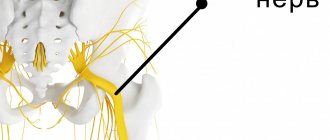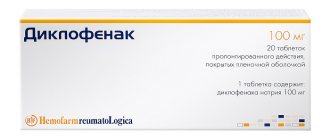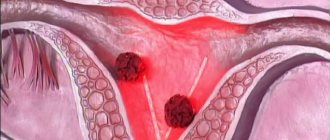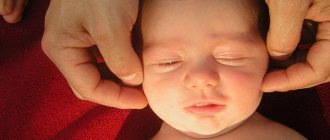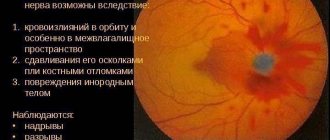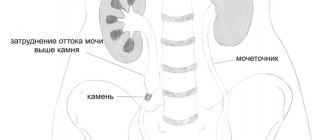The sacral nerve plexus consists of the anterior branches of the 4th and 5th lumbar nerves, as well as 4 sacral nerves (SI - SIV). When connected, the nerve fibers form the thickest nerve of the human body - the sciatic. A pinched nerve in the sacrum occurs from mechanical compression of the nerve roots of the sacral plexus.
The process is caused by pathological formations in the lumbosacral spine and muscle spasm. Lesions of the nervous system are accompanied by severe pain, disruption of the functioning of internal organs, and numbness in areas of the body innervated by pinched nerve fibers.
Possible causes of a pinched nerve in the sacrum
The most common causes of compression of nerve fibers are considered to be damage to the tissues and organs of the sacrum as a result of degenerative changes: trauma, congenital or acquired anomalies of the spine, various diseases. The most common factors contributing to pinched sacral nerves are:
- professional sports, intense training;
- carrying heavy objects, improper redistribution of load when lifting heavy objects;
- arthrosis, osteoporosis, osteochondrosis with degenerative-destructive changes in the musculoskeletal system;
- spondylosis, leading to the appearance of osteophytes on the vertebrae;
- displacement of the vertebrae and intervertebral discs, intervertebral hernia;
- neoplasms of the lumbosacral region;
- disruption of the hormonal system;
- the presence of infectious acute or chronic diseases;
- muscle spasms, hypothermia, draft, stress;
- pregnancy period, childbirth;
- sedentary work activity, immobile lifestyle, excess body weight;
- insufficient intake or low level of vitamins and minerals in the body.
An aggravating factor is age-related changes in bones and joints. This circumstance significantly complicates the treatment of pinched nerves of the sacral plexus.
Causes of a pinched nerve in the lower back
Pinching of the lumbar nerve can occur as a result of progressive intervertebral hernia and osteochondrosis - common diseases of the musculoskeletal system. Predisposing factors to the development of these conditions may be:
- excessive physical activity;
- lifting weights;
- hormonal imbalance;
- diseases of the endocrine system;
- overweight;
- old age.
A pinched nerve in the lower back also appears as a result of neoplasms. When the first symptoms of compression neuralgia appear, it is necessary to seek medical help as soon as possible, since the absence of treatment can lead to the development of paralysis of the lower extremities.
Treatment of a pinched lumbar nerve
Adequate treatment of the disease largely depends on correct diagnosis. Conservative and surgical treatment are possible.
The first group consists of physiotherapeutic, manual procedures and drug treatment. During treatment for a pinched nerve in the lower back, the patient is advised to rest in bed on a hard surface that provides better nutrition to the spine. The most effective physiotherapy techniques are:
- electrophoresis;
- UHF drugs;
- ultrasound therapy;
- magnetic therapy;
- massotherapy;
- acupuncture.
Unfortunately, services for the treatment of lumbar nerve entrapment have been suspended. Familiarize yourself with the symptoms of the disease and contact your doctor.
Cosmetic procedures are contraindicated during pregnancy and lactation.
Symptoms and clinical manifestations
Signs of the disease depend on the type of pinched nerves, the causes of their compression, the degree of damage, as well as the presence of inflammatory processes and concomitant diseases. The main manifestation of pinching in the sacrum is sharp pain in the back and legs. When a sensitive group of nerves is compressed, painful attacks are observed, during which it is difficult to even move. Compression of motor or autonomic nerve fibers occurs with less severe symptoms.
Depending on the location, the following types of pain are distinguished:
- sciatica – pain radiates to the sacrum, buttocks, back of the legs, tailbone;
- lumbodynia – extends to the lumbar region;
- lumboischialgia – combines pain in the lower back and legs.
The disease is characterized by unexpectedly occurring pain syndrome, regardless of the load. The feeling of pain is shooting, piercing or burning in nature, its intensity increases during coughing, laughing, sneezing.
In addition to pain, characteristic signs of pinched sacral nerves are:
- feeling of weakness, loss of sensitivity;
- numbness in various parts of the lower back, back of the legs from hip to heel;
- gait disturbance, decreased motor capabilities;
- swelling and hyperemia of the skin;
- headaches, increased sweating.
Clinical signs of sacral pinching usually intensify with the arrival of night or in a state of emotional arousal, when the body is exposed to low temperatures and drafts.
Symptoms of a pinched nerve in the spine
The clinical picture of the pathology depends on the location where the pinching occurred, therefore there are several types of pain syndrome:
- cervicalgia - pain and tension in the neck muscles, often accompanied by headache, dizziness, limited mobility and decreased visual acuity;
- cervicobrachialgia – neck pain radiating to the arm;
- sciatica – lower back pain that spreads along the back of the leg and can reach the foot;
- lumboischialgia - pain in the lumbar region, spreading to the thigh, one or both lower limbs;
- lumbodynia – pain in the lumbar region.
A disc herniation can occur in any part, but most often it forms in the lumbosacral region.
If the nerve is pinched in the cervical region, pain can be felt not only in the neck, but also in the occipital, cervical-collar area and arm on the affected side. If the nerve is damaged at the level of the 3rd vertebra, there may be numbness in the sublingual area, changes in taste and difficulty speaking.
Damage to the nerve near the 4th vertebra is accompanied by discomfort and pain in the area of the collarbone and forearm, decreased muscle tone, and dysfunction of the respiratory system. Sometimes the pain radiates (gives) to the chest and right hypochondrium.
A characteristic sign of a pinched nerve at the level of the last vertebrae C 6 - C 7 is weakness and numbness of the upper limb from the shoulder to the hand.
A sharp and piercing pain between the shoulder blades accompanies intercostal neuralgia, in which the intercostal nerves extending from the spinal roots are compressed. In this case, the back also hurts in the area of the ribs, often the pain syndrome is of a girdling nature.
Inflammation of the lumbar nerve is manifested by intense shooting and throbbing pain. It is most pronounced in the first half hour after the onset of the attack and can last up to several hours, then gradually passes.
If the sciatic nerve is damaged (lumbosacral radiculitis), the pain occurs mainly in the gluteal region and the back of the leg. Moreover, the pain can affect both the entire limb and its individual parts - for example, it can be felt only in the popliteal fossa, thigh or lower leg. In most cases, the lesion is unilateral.
The mechanism of pain development is almost always the same and does not depend on the cause. As a result of shift or deformation of the vertebral structures, excitation of many nerve endings occurs, which are supplied to the outer ring of the disc and the ligamentous apparatus. The result is severe pain and spasticity in the muscles surrounding the spine.
What to do if a nerve is pinched in the sacrum
Anti-inflammatory analgesics
First aid for a person whose sacrum is jammed is to ensure a comfortable position and rapid pain relief. If sharp pain occurs in the lower back or legs, the patient takes a forced position and cannot move independently. It is necessary to help him get to the bed; if this is not possible, carefully lay him on a flat surface.
Any analgesics (Ketanol, Analgin) are suitable for pain relief. Sedatives will help alleviate the condition. If you have a high temperature, take antipyretic anti-inflammatory drugs.
When the person feels better, you can try to get up. This must be done carefully, first get on all fours, then on your feet. It is recommended to secure the lumbar spine with a bandage or elastic bandage. To find out the true diagnosis and further treatment, contact a medical facility.
Treatment options
The treatment strategy for pinched sacral nerves depends on the examination results. First of all, the patient is recommended to rest in bed. The following medications are prescribed as conservative medicine:
- nonsteroidal anti-inflammatory drugs that relieve pain (Ibuprofen);
- novocaine injections (blockades);
- For local application, ointments, gels, creams (Diclofenac, Finalgon, Capsicam, Fastum), mustard plasters, compresses are used;
- means for stimulating the immune system.
Exercises for lower back pain
Drug treatment is supplemented with physiotherapeutic methods, reflexology, water treatments, diet, and massage. At home you can be treated using traditional medicine methods, as well as do therapeutic exercises.
Exercises for a pinched nerve in the sacrum are aimed at stretching the muscles and other anatomical structures that compress the nerve fibers.
When conservative treatment does not bring results, surgical methods of therapy are resorted to. For further rehabilitation, as well as to prevent relapses of the disease, sanatorium treatment is recommended.
Causes of pinched nerve in the lumbar region
Any negative impact on the nerve endings manifests itself in the form of unpleasant sensations, and every movement only aggravates the situation. Various diseases can cause this condition; a pinched nerve in the lower back becomes only a consequence. The following ailments provoke pain:
- Intervertebral hernia. It occurs due to compression of the intervertebral discs due to changes in vertebral spaces and displacements. The hernia protrudes from the spinal column and puts pressure on the nerve.
- Spinal diseases. The main one in this group is osteochondrosis, which develops after deformation and displacement in the spinal column. At the same time, compression occurs, causing pressure on the nerve endings in the lower back.
- Injury. A pinched nerve in the lumbar region is sometimes caused by physical force, which can lead to serious complications.
- Muscle spasm. Abnormalities in contraction and inflammation of muscle tissue can cause pinched nerves and back pain.
- Pregnancy. With rapid weight gain by the fetus in the last months of gestation, the center of gravity shifts sharply, which increases the load on the lumbosacral region. This causes a pinched nerve.
- Excessive loads. When playing sports or when the muscle corset is weakened, displacement of the vertebral discs can cause additional physical activity. As a rule, it happens when the back is straightened.
- Tumor. Any neoplasm in the lumbar region can reach such a size that there is pressure on the roots of the spinal cord.
- Excess weight puts additional stress on the vertebra in the lumbar area, which can lead to a pinched nerve.
Prevention of pinched nerve in the sacral region
On an orthopedic mattress, the body retains its anatomical curves.
Prevention of pinched nerve fibers includes the following preventive measures:
- maintain the body in healthy physical shape, get rid of excess body weight;
- maintain correct posture;
- maintain an active motor mode, avoid a sedentary lifestyle;
- try not to injure or overload the musculoskeletal system, do not make sudden movements while playing sports;
- if you have osteochondrosis, be regularly examined by a doctor;
- devote enough time to rest, choose a mattress for the bed with a firmness that matches individual characteristics;
- protect yourself from hypothermia and drafts, completely cure infectious and inflammatory diseases.
Following medical recommendations and taking care of your health will help minimize the risk of developing compression of the nerve endings of the sacral plexus.
Manifestations of pinched nerves in the sacrum can bother you for a few minutes or drag on for weeks. The chronic stage occurs with minor pain and mild numbness. Even if the unpleasant sensations can be tolerated, you should consult a doctor to identify the causes of nerve compression and undergo a course of therapeutic measures.
Why is pinching dangerous?
A pinched nerve in the sacrum requires urgent treatment. Compressed nerve roots gradually die. Because of this, the transmission of impulses is disrupted, and pathologies of internal organs develop. Possible complications of pinching:
- disorders of defecation, urination,
- erectile disfunction,
- muscle weakness,
- numbness of the skin and loss of sensation,
- mobility impairments, etc.
Timely treatment of a pinched nerve in the sacrum will help cope with pain and fully restore the function of damaged nerve endings. If you do not seek medical attention early, tissue degeneration will be irreversible.

